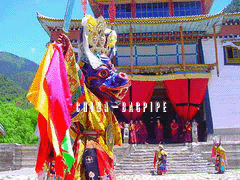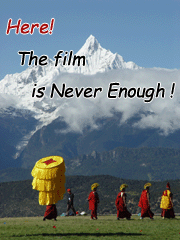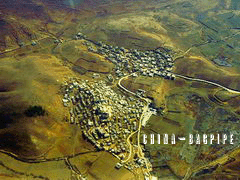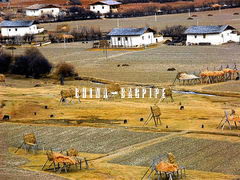The
Shangri-la Tour Route (19
ROUTES)
|
Your
Country
|
|
Chengdu
|
|
Diqing |
|
 |
|
Your
Country
|
|
Guangzhou
|
|
Diqing |
|
 |
|
Your
Country
|
|
Kunming
|
|
Diqing |
|
 |
  
Diqing
Tibetan Autonomous Prefecture is located in the northwestern
part of Yunnan Province. Under its jurisdiction, there are
three counties, i.e., Zhongdian, Deqin and Weixi. Total
population of the whole prefecture is 340,000, in which
112,000 are Tibetans, accounting for :33% of the total. It
is also the home of another 25
nationalities, including but not limited to Han, Bai, Yi,
Hui, Pumi, Lisu and Miao. The total area of the whole
prefecture is 23,870
㎢.
In Tibetan language, the word "Diqing" means "A Land of Happiness
and Good Luck". This tour destiny with unique
characteristics, sitting in the heart of Conjoint of Three
Rivers (Nujiang River, Lancang River and Jiasha River), is a
national level scenic resort. It is the only way to go to
Tibet from Yunnan. As one part of the former Kangba Area, it
has the names of "-lea-horse Ancient Road" and the southern
"Silk Road" in history. Today, the 214 National Highway from
Shanghai-Yunnan-Tibet passes through the whole territory,
and there are flights flying directly to
Kunming,Guangzhou,Chengdu and Lhasa.
On May 5th, 2002, the weather was sunnywith a clear sky.On that
day, the name of Zhongdian County,the capital of Diqing
Tibetan Autonomous Prefecture, was solemnly changed to
Shangri-la County.
The word "Shangri-la" originally came from the novel Lost Horizon
written by Jam-es Hilton, a famous English writer, in April
of 1933. The book depicts four westerners in the early 20th
century. Due to "an accident", they were brought to a
Tibetan ar-ea
 named
"Shangri-la." The novel describes the area as "the Eden."
After the novel was published, it produced a great effect in
the world. Later the word "Shangri-la" also became the word
indicating "the Eden on the Earth" in English, and
explorations to "Shangri-la" were initiated from every part
of the world almost half a century ago.
People often gain lots of discoveries when they are
continuously seeking. named
"Shangri-la." The novel describes the area as "the Eden."
After the novel was published, it produced a great effect in
the world. Later the word "Shangri-la" also became the word
indicating "the Eden on the Earth" in English, and
explorations to "Shangri-la" were initiated from every part
of the world almost half a century ago.
People often gain lots of discoveries when they are
continuously seeking.
What is most exciting is that, someone discovered a word ---"Shangbala"
that has the same meaning as "Shangri-la." Some records
about "Shangbala" were discovered in documents on Tibetan
Buddhism. In addition, a book named Gu ide
to the Kingdom of Shangbala written by Banchan the Sixth
(according to the Great Tibetan Buddhist sutra) has also
been found. Thus, most of scholars now believe that,
"Shangri-la" and "Shangbala" are originally same. Both
represent "the perfect world". ide
to the Kingdom of Shangbala written by Banchan the Sixth
(according to the Great Tibetan Buddhist sutra) has also
been found. Thus, most of scholars now believe that,
"Shangri-la" and "Shangbala" are originally same. Both
represent "the perfect world".
During the ten years since the novel Lost Horizon was
published, there were already a number of dream-seekers who
were seeking the Shangri-la of their hearts around the vast
Tibetan area. In addition to the fact that these adventurers
were all from the west, they also had one belief in common:
there exists a greater wisdom m oriental culture. Some of
them ultimately announced that they have become the apostles
of "Shangri-la".
Over the past half of the century, many people have declared that
they had found Shangri-la, but these statements have not
been widely acknowledged. When Time stepped into the last
decade of the 20th century, more and more travelers went to
Diqing Plateau in Yunnan. Finally, some people found a
pleasant surprise. The mystical Diqing Plateau was so
similar to the Shangri-la described by the novel Lost
Horizon! It aroused the worldwide attention. One researcher
or team after another made special trips to Diqing because
the discovery had obtained worldwide acknowledgement.
It is probably because history has a special fondness for Diqing
--in Tibetan lang-uage the literal
 meaning
of Diqing is "the place of happiness and good luck." Or it
is because the earth is in deep love with Diqing ---the name
of a place "Nirizong" originally means the city of "the sun
and the moon", while "Shangri-la" in Tibetan Language means
"the slope leading to the sun and the moon in the heart." meaning
of Diqing is "the place of happiness and good luck." Or it
is because the earth is in deep love with Diqing ---the name
of a place "Nirizong" originally means the city of "the sun
and the moon", while "Shangri-la" in Tibetan Language means
"the slope leading to the sun and the moon in the heart."
Both phrases, "the city of the Sun and the moon" and "the slope
leading to the sun and the moon in the heart", have the same
meaning except that the latter seems more solemn, which
exactly fits with the spirit that Tibetan people would like
to live with gods and the aspiration that people and nature
will grow in harmony. Moreover, the pictures of the sun and
moon are universally placed in Lamaseries, Lama towers and
people's dwellings of Tibetan areas in Diqing, from which we
can see that the people there have placed themselves in "the
slope leading to the sun
and the moon in the heart." That is the world of Shangri-la.
Besides, the areas within the Zhongdian county traveled by the
Jinsha River from Wujing village to Luoji village has formed
the marvelous shape of a large "V". Had it been decreed that
this place would exclude other places to be the real
"Shangri-la"? Moreover, what is most incredible is that,
another name for Zhongdian is "Jiantang", which is justly
indicating "victory" in Tibetan language.
On this mysterious, beautiful and pure land, there is t he
Baimang Snow Wt. Natio-nal Level Nature Conservancy, and
three provincial level nature conservancies, i.e., Bita
Lake, Napa Lake and Haba Snow Mt. It covers the snow
mountains, meado-ws,canyons, lakes, monasteries, folklores
of Shangri-La, and it is a holy land in which man and the
gods stay together, where man and nature live in harmony. It
is a remarkable place producing outstanding people. It has
wonderful natural landsca-pe, many mysterious human relics,
and colorful nationality folklores, rich and unique he
Baimang Snow Wt. Natio-nal Level Nature Conservancy, and
three provincial level nature conservancies, i.e., Bita
Lake, Napa Lake and Haba Snow Mt. It covers the snow
mountains, meado-ws,canyons, lakes, monasteries, folklores
of Shangri-La, and it is a holy land in which man and the
gods stay together, where man and nature live in harmony. It
is a remarkable place producing outstanding people. It has
wonderful natural landsca-pe, many mysterious human relics,
and colorful nationality folklores, rich and unique
specialties.
The
Shangri-la Tour Route (19
ROUTES)
To
enjoy the Shangri-La view, Tour to
Tibet,
Yunnan,
Sichuan
is recommended.
|

